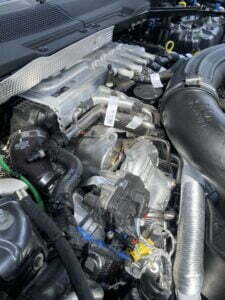The Land Rover TD5 Defender And Discovery Engine: All You Need To Know
An engine is the most important aspect of any car. It is the aspect that can make or break the decision of purchasing that specific model. Land Rover or JLR (Jaguar Land Rover) needs no introduction, known the world over for making vehicles that can both handle the roughness of off-road driving while delivering a comfortable and engaging drive.
The TD5 engine in the Defender from 1998 to 2006 and in Discovery from 1998 to 2005 was spectacular and is considered to be one of the best engine (if not the best) Land Rover has ever produced. Here is everything you need to know about it.
The History
From 1998 onwards, both the Defender and discovery 2 were fitted with this engine. Although the Engine was the technically the same in both vehicles the Discovery 2 was designed to have slightly more BHP (136Bhp instead of the 122Bhp of the Defender)
The TD5 engine was the first diesel engine inside the Defender range that was completely controlled by an ECU (Engine Control Unit). The project name for this was Storm. The ECU unit regulates fuel delivery through several factors such as temperature, inlet air pressure, intake airflow, driver demand, ambient pressure to list just a few. It should also be noted that this was the first Land Rover product to run a “drive by wire” system. What is meant by this is that there is no physical connection between the engine and pedal. The throttle pedal is a potentiometer that references to a signal put out by the ECU (nominally 5V) which decreases and increases when operating.
Over time, we can see that the TD5 is one of the most reliable engines that was ever created by Land Rover. Even now 20 years on these electronics are still going strong and to think when they first came out people’s reaction was its way over complicated. But compared to today’s standard this is very simple and basic in how it works.
Brief Overview of the TD5 Engine
The TD5 engine was a result of many changes happening in emissions and safety legislation. At that time, Land Rovers current line-up of engines couldn’t hit the new emissions standards so was becoming obsolete.
That is why it was decided by Land Rover that a new diesel engine should be created to meet all these requirements for the now and for the immediate future.
The name of this project was Project Storm and Land Rover took over the responsibility of building the new diesel engine. Unfortunately during this time Land Rover ran into financial difficulties and was sold to the BMW group who at the time of purchasing offered NO 4×4 derived vehicles of their own.
One Rover Group was taken over by the BMW Group, they brought their own range of diesel engines that made project Storm redundant. The five-cylinder version did however make it to production and it was fitted to the Defender and Discovery models.
It offered more power and drivability than the previous engines and it was a complete game-changer for Land Rover. The engine has proved itself from time and time again it can be neglected in terms of servicing it can still run if an injector goes down it’s just very well engineered product built to do a job that at the time none of the competition could offer.
TD5 Remap
The best thing about the TD5 engine is that it is one of the most tunable engines developed by Land Rover. The factory fuel maps must cover a wide range of uses, global territories, emissions specifications, and much more. That is why a TD5 remap has the potential to double the BHP of this engine even 20 years on!
The TD5 remap will also increase the flexibility and the drivability of the Defender and Discover range. Besides that, it will also improve fuel economy and increase torque and power for the best results. If you want to improve your Land Rover Discovery or Defender significantly, then a TD5 engine remap is a necessity.
Huge gains are possible just from software however if you are wanting the ultimate from your TD5 then changing to one of our Hybrid Turbos or VNT turbo will give you numbers that would shock even modern day vehicle’s. Bringing the TD5 up to modern standards!
Get your Nanocom TD5 remap here > https://www.empiretuning.co.uk/product/nanocom-td5-remap/
TD5 Immobiliser Removal
Security is one of the most important aspects of owning a car, especially a Land Rover. However, as these vehicles are ageing components do fail and can unfortunately leave you stranded. We can stop that issue ever arising by removing the Immobiliser within the ECU making it free to run on any TD5 vehicle. Obviously in some instances this isn’t ideal but if you are taking on an engine conversion and the engine fails to start due to lack of security hardware in the conversion, this solution will remedy that
That is why many owners of the Land Rover Discovery and Defenders have their immobiliser removed to make sure that any possible issues that arise further down the line are already accounted for. It drastically improves the reliability and flexibility of the car/ecu giving back the confidence you once had.
This service is available through our webshop and can be found here. > TD5 Immobiliser Removal Defender and Discovery
Post-2007 Changes
The TD5 engine was installed in cars that were produced till 2006. After that, many changes were needed to meet the safety and emissions legislation EU4/EU5. Unfortunately this is what stopped the TD5 from continuing production and the fact Land Rover instead of building their own engines bought them in from other manufactures like Ford who actually bought LR from BMW
Final Words
That was a small guide to the TD5 engine definitely one of the greatest engines Land Rover has ever built till this day! It only in recent years that Land Rover have gotten back into the engine building market themselves with the current Igenium line ups, which to be honest are still having issues with quality and reliability.
Will the new 3.0 Diesel inline 6 change Land Rovers fortunes? Lets hope so our first impressions are its fantastic!

New Defender 90 Diesel 6 Cylinder



